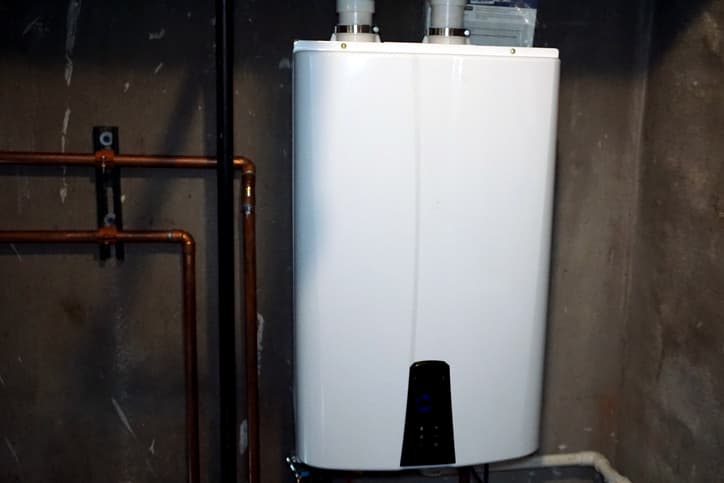
Hot water is a necessity that likely never crosses your mind. It’s one of the multitudes of everyday luxuries that is taken for granted. Like many of these luxuries, you don’t realize how important hot water is until you can’t access hot water in your home.
Whether your old water heater broke or you are in the market to buy a unit that better suits the needs of your household, you may be stuck on how to install a tankless water heater. Luckily, you’ll find a step-by-step on how to install a tankless water heater as you continue reading.
It’s important to note that you should only attempt to replace a water heater if you have all of the necessary technical experience and knowledge. If not, consider hiring a professional plumber to get the job done quickly and efficiently.
When to Replace a Water Heater
Multiple situations can lead to needing a replacement water heater. Some of the most common reasons for replacing a water heater include:
- Your old water heater has broken or is not functioning at its highest capacity.
- You need to increase or decrease available hot water after the size of your family has shifted in your home.
- Improving energy efficiency and saving money on utility bills with a new and efficient unit.
When considering buying a tankless water heater, it’s essential to understand the pros and cons of this type of unit. On the positive side, a tankless water heater is highly efficient and can save you money on utilities. On the other hand, a tankless water heater will heat water on demand and has a limit. If the number of people in your household has decreased, a tankless water heater will be the perfect fit for your home.
A Step-By-Step Guide to Installing a Tankless Water Heater
Removing your old water heater
- Start the removal of your water heater by shutting off the water supply to the unit. There should be one inlet and one outlet valve.
- Disconnect the water lines from the old water heater unit using a pipe wrench or pliers.
- Open the drain valve at the bottom of the unit to drain excess water from the unit. Ensure you have a bucket or a nearby drain to catch the water and avoid a mess.
Important notes:
- If your old water heater is gas-powered: Turn off the gas line valve and proceed to disconnect the gas line.
- If your old water heater is electric: Turn off the circuit at the service panel and check to ensure it is off. Then, disconnect the wires from the unit and remove the unit. Remember that electric units use a 240-volt power supply, and the risk of hazardous electrocution is possible.
In either case, proceed with absolute certainty of your skills, or call a professional plumber to disconnect your water heater.
Installing your tankless water heater
- Make sure you install your new tankless water heater flush against a wall. You can set the unit into the wall by locating studs in your walls and setting the unit between the studs of the wall. Instructions will vary depending on the unit you are installing. Follow the manufacturer’s guide to place your tankless water heater properly.
- Locate the inlet and outlet water pipes and valves from removing your old unit. When installing the water pipes to your new unit, be sure that the pipe from the water utility connects to the inlet. Ensure the pipe leading to your house connects to the outlet.
- Find and install shutoff valves on both water lines leading to the unit. Additionally, you might have to add a pressure-relief valve to the water pipes. Using union fittings, secure the water pipes to the main water heater unit.
- Do not turn on gas or electricity to your water unit. With gas and electricity still powered off, open the water valves. Open faucets throughout your house and let the water run for about a minute or two.
- Turn off the water valves.
- Next, remove the inline filter. You can find the inline filter near the inlet. Once you find the inline filter, remove the filter and clean any debris that has accumulated on the filter.
- Once clean, replace the inline filter and open the water valves again.
- If the new unit you’re installing is gas or electric, restore gas and electric connections.
- Once all connections are secure and properly installed, test your unit to ensure it functions correctly.
Related: How To Install Electric Water Heater
Benefits of Hiring a Local Plumber
Self-installation of your new tankless water heater may be an enticing approach to saving some money. While a DIY installation might save you some money, if you lack the technical skills and knowledge of local building codes, you could find yourself spending more money than you would by hiring a professional plumber.
Potential risks of self-installation, especially if you do not have the required technical skill and knowledge, include:
- Potential hazardous electrocution
- Spending additional money on incorrect parts
- Violating building codes before, during, or after water heater installation
- Flooding or other property damage from incorrect installation
Hiring a professional plumber will ensure that your new tankless water heater installs quickly and precisely. When it comes to having hot water in your home, hiring a professional to get the job done quickly will ensure that you are not without hot water for an extended amount of time.
Is it easy to install tankless water heaters? For a professional plumber, the answer is an absolute yes. While it is possible to change out your old water heater and install a new one on your own, attempting to do so without the technical skills could lead to expensive messes and harm to yourself or your home.
Call a professional plumber to get the job done well, mitigate risk, and get efficient hot water back in your home.
Need help installing your water heater? You can count on the plumbing experts at Larkin Plumbing. Contact us to schedule service today!
E., (2022). How to Install a Tankless Water Heater? (Step-by-Step Tutorial).
Vandervort, D. (2021). How to Install a Tankless Water Heater.

